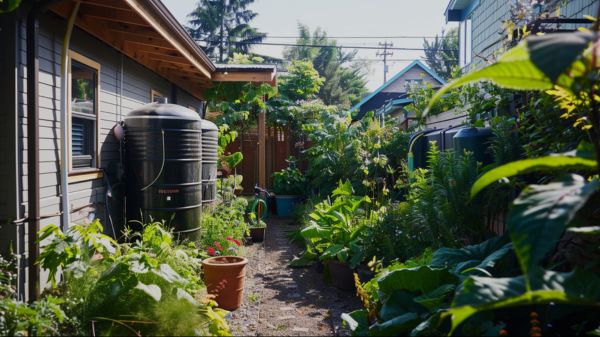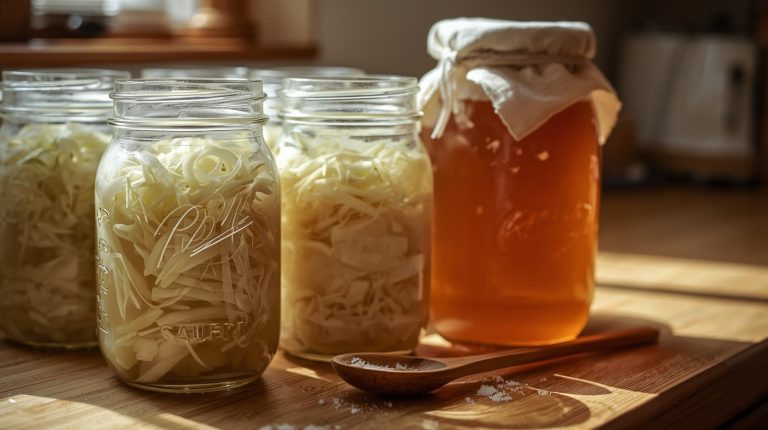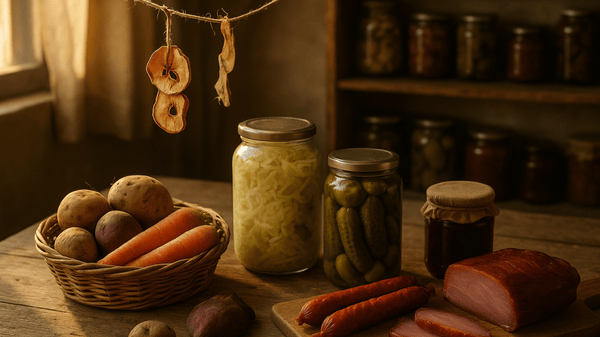To tackle water scarcity and guarantee an endless source of fresh clean water, you can implement a DIY approach using rainwater harvesting and advanced filtration techniques. Start by setting up a rain barrel system to collect and store rainwater from your rooftop; make sure it’s made from UV-resistant materials and properly maintained. Combine this with a robust filtration method, such as reverse osmosis or UV purification, to remove contaminants and pathogens, assuring water safety and palatability. Regular system checks and proactive maintenance are essential to sustain this self-sufficient water supply. Exploring these strategies further could greatly enhance your water independence and resilience.
Key Takeaways
- Install a rainwater harvesting system to collect and store rainwater for household use.
- Utilize reverse osmosis filters for removing contaminants and ensuring water purity.
- Set up UV purification systems to disinfect water by neutralizing harmful microorganisms.
- Incorporate activated carbon filters to improve water taste and remove impurities.
- Perform regular maintenance on your water systems to sustain efficiency and water quality.
Understanding Water Scarcity
Water scarcity affects over two billion people globally, highlighting a critical need for sustainable management of this essential resource. You’re smack in the middle of a dry spell of understanding, aren’t you? Let’s sprinkle some knowledge.
First off, climate change isn’t just about sweaty summers and blooming daisies in January. It’s altering precipitation patterns and ramping up evaporation rates, which messes with the availability of fresh water like a bad plumbing job.
Then there’s population growth; more people mean more mouths to hydrate, more bodies to bathe, and more food to grow—which leads us right into the agricultural impact. Agriculture gulps down about 70% of our global freshwater supply, and it’s not just sipping daintily. It’s more like a teenage boy after soccer practice.
Speaking of practices, incorporating water conservation methods into our daily routines like harvesting rainwater and reusing greywater can greatly reduce water consumption. Not only does this help conserve our precious resource, but it also benefits the environment by reducing our reliance on treated, potable water.
Throw in some urbanization effects, where expanding cities pave over paradise and you’ve got less natural land to absorb rainfall, leading to increased groundwater depletion.
And don’t get me started on the ecosystem health; water bodies aren’t just water coolers for wildlife—they’re complex systems that thrive on balance.
Conservation strategies? Technological innovations? They’re our hope. From smarter irrigation tech to water rights discussions, it’s not just about turning off the tap while you brush. It’s about big ideas for thirsty times.
Basics of Rainwater Harvesting
Diving into the basics of rainwater harvesting, you’ll find it’s not only a practical solution but an essential one for addressing water scarcity and promoting sustainable water practices. Let’s splash into the details!
First off, identifying your rainwater sources is like finding a treasure map in your own backyard. Most homes can collect rain from rooftops, which is like catching liquid gold with the right setup.
Using effective collection methods like rain barrels or even more complex systems like rain gardens and drip irrigation can transform your home into a water-saving fortress. But before you start channeling your inner water pirate, you need to understand the collection techniques. Simple gutters and downspouts can do the trick, funneling water into a storage unit with the elegance of a ballroom dance.
Speaking of storage options, think of them as your water bank. Options range from humble barrels to massive tanks, depending on how thirsty you are—or rather, your garden and toilet.
But here’s the kicker: system sizing isn’t one-size-fits-all. It’s tailored to your roof’s real estate and your local rainfall patterns, which can be as unpredictable as a plot twist in a mystery novel.
Now, don’t forget to peek at local regulations; some places are as strict about collecting rain as a librarian is about noise. And while you’re at it, consider the environmental impact. Opting for eco-friendly materials and designs can make your rainwater system a hero in the green community.
Plus, engaging in community initiatives and looking into system upgrades can keep your setup in tip-top shape, ensuring you’re always ready for whatever the clouds throw your way.
Setting Up a Rain Barrel System
Now that you’re familiar with the basics of rainwater harvesting, let’s focus on setting up a rain barrel system. Choosing the right rain barrel can be as important as picking a dinner date for your goldfish: you need compatibility, reliability, and something that doesn’t leak all over your plans—literally.
It’s worth noting that rainwater harvesting not only provides an alternative water source, but also contributes considerably to water conservation.
Here’s what you need to keep in mind:
- Rain Barrel Selection: Opt for barrels made of UV-resistant materials and make certain they’ve a proper lid to keep out debris and critters. Size matters too; bigger can be better but depends on your roof’s catchment area.
- Installation Tips: Place your barrel on a stable, elevated surface to help increase gravity-driven water pressure. Make sure it’s near a downspout for ideal collection efficiency.
- Overflow Management: Install an overflow valve to divert excess water away from your foundation—unless you fancy a basement swimming pool.
Advanced Water Filtration Methods
As you explore advanced water filtration methods, it’s essential to understand the mechanics and effectiveness of reverse osmosis, which employs a semi-permeable membrane to remove up to 99% of waterborne contaminants. UV purification techniques offer another layer of safety by using ultraviolet light to inactivate pathogens without adding chemicals.
Reverse Osmosis Essentials
Understanding the principles of reverse osmosis is essential for implementing advanced water filtration methods effectively. At its core, reverse osmosis systems use membrane filtration to sift out almost every microscopic enemy of purity from your water, making it safe and delightful to drink.
Here’s what you need to know about reverse osmosis, broken down into bite-sized, digestible chunks:
- Pressure is Key: Water must be pushed through the semi-permeable membrane at high pressure to separate the nasties from your drinking water. No pressure, no purification. It’s like trying to squeeze toothpaste out of a sealed tube!
- Membrane Matters: The semi-permeable membrane is the heart of the system. This isn’t just any filter; it’s a high-tech barrier that even the smallest of contaminants can’t sweet-talk their way past.
- Maintenance Is a Must: Keep your system in excellent condition by regularly replacing filters and cleaning the membrane. Think of it as pampering your purifier so it can continue to pamper your water.
UV Purification Techniques
After exploring the detailed mechanics of reverse osmosis, let’s examine another sophisticated method of guaranteeing water purity: UV purification techniques. You might think UV technology sounds like something out of a sci-fi movie, but it’s actually grounded in serious science and is all about zapping those nasty germs to oblivion!
Here’s the scoop: UV purification uses ultraviolet light to disinfect your water by breaking down the DNA of bacteria and viruses. Yes, you’re basically throwing a sunburn party for pathogens, and you’re not inviting them back. This method is effective, chemical-free, and doesn’t alter the taste or odor of your water—so you won’t be sipping eau de swimming pool.
Now, to the nitty-gritty: when water flows through a UV system, it’s exposed to a wavelength of light (typically around 254 nanometers) that’s lethal to microorganisms. It’s like a microscopic security system that guarantees water safety without the fuss of chemicals.
And don’t worry about power consumption; these systems are surprisingly energy efficient.
Activated Carbon Benefits
Now, let’s plunge into the benefits of activated carbon in advanced water filtration methods. You’re probably wondering how this black, grainy stuff can be your water’s new best friend.
Well, activated carbon isn’t just any char; it’s a micro-pore wizard, capturing impurities like a pro. Here’s why you should consider it for your water filtration needs:
- Taste and Smell Savior: Activated carbon excels at removing odors and improving taste. It’s like having a tiny, invisible chef that specializes in making your water taste and smell better.
- Chemical Catcher: This stuff is fantastic at trapping unwanted chemicals such as chlorine and pesticides. Imagine it as a superhero, capturing villains that make your water less appealing and potentially harmful.
- Longevity and Efficiency: With a great surface area packed into just a tiny volume, activated carbon filters can last longer and work more efficiently than many other filters. It’s like getting a luxury car’s performance for the price of a scooter.
In a nutshell, activated carbon in water filtration is like having a tiny, efficient clean-up crew in your water system, ensuring that every sip you take is purer, tastier, and safer.
Don’t just go with the flow; make sure it’s filtered!
Maintenance and Troubleshooting
Regular maintenance is essential to guarantee your water filtration system operates efficiently and continues to provide clean water. Let’s plunge into the nitty-gritty without getting our feet wet, shall we?
First off, you’ll wanna tackle filter replacement like it’s a dirty sock—regularly and without hesitation. Data from the Department of Obvious Observations suggests filter life expectancy plummets faster than your enthusiasm at a free accordion concert if neglected.
Next up, leak detection. Don’t let leaks lurk like uninvited party guests. A simple visual check can save gallons of potential mayhem. Now, on to system cleaning and seasonal checks—think of it as a spa day for your filtration system. Scrubbing and inspection during spring and fall can prevent the kind of surprises nobody wants.
While you’re at it, keep tabs on water quality. A poor taste or odd color could signal an issue faster than you can say “contaminants.” Don’t forget overflow management and pump maintenance. It’s less about if and more about when. Regular checks can keep you from an indoor swimming experience.
Ensure Your Family’s Water Security with Air Fountain
Benefits of Self-Sufficient Water Supply
By establishing your own water supply, you’ll considerably cut down on utility bills, as studies show that self-sufficient systems can reduce water costs by up to 50% depending on local rates and usage patterns. Additionally, having an independent water source enhances your preparedness for emergencies, providing a reliable supply when public systems may fail. This resilience is critical, especially in areas prone to natural disasters where water infrastructure can be compromised.
Reduces Utility Bills
Embracing a self-sufficient water supply greatly cuts down on your monthly utility expenses. You’re not just saving water; you’re hoarding cost savings like a squirrel with nuts for the winter.
By tapping into technologies like rainwater harvesting or installing a well, you can greatly reduce your reliance on municipal water systems, which, let’s be honest, tend to take a hefty sip out of your wallet.
Here’s the breakdown:
- Lower Water Bills: Once you’ve set up your system, the cost of water plummets to almost zilch. You’re using what nature provides, free of charge, minus the initial setup and occasional maintenance. Think of it as nature’s buy-one-get-a-lifetime-supply-free deal.
- Energy Savings: Reducing the energy used to pump water from central systems cuts your energy bill. It’s like losing weight by cutting out midnight snacks—simple but effective.
- Long-term Financial Benefits: The upfront investment in a water system pays off. Data shows that homes with self-sufficient systems save on average 20-30% annually on water costs.
Enhances Emergency Preparedness
While reducing your utility bills offers significant financial relief, establishing a self-sufficient water supply also dramatically boosts your home’s resilience in emergency situations. Imagine a situation where your local water supply decides to take an unexpected vacation during a natural disaster. Not ideal, right? That’s where your home-based, rebel water supply steps in.
By implementing sustainability practices and focusing on water conservation, you’re fundamentally building your own emergency kit that doesn’t require batteries or expire. In times of drought, while your neighbors might be sweating over restrictions or grappling with the societal equivalent of a low-pressure shower, you’ll be sitting pretty with your proactive drought preparedness plan.
It’s not just about surviving on your wits and a prayer; it’s about thriving with resource management that makes Bear Grylls look like an amateur. The setup of a self-reliant water system allows you to maintain critical hygiene and cooking needs, which are fundamental in keeping morale high and stomachs full.
Additionally, leveraging community resources can amplify your efforts, turning your lone-wolf survival strategy into a pack-led triumph.
Frequently Asked Questions
Can Rainwater Harvesting Systems Affect Local Groundwater Levels?
You might wonder if collecting rainwater affects local groundwater levels. Well, yes, it can. When you harvest rain, it reduces surface runoff, enhancing groundwater recharge. This means more water seeps into the ground, potentially improving groundwater levels and water quality. However, without proper filtration, it might introduce contaminants. So, while you’re feeling like an eco-hero, remember to keep your system clean unless you fancy a side of pollutants with your groundwater cocktail!
Are There Legal Restrictions on Rainwater Collection in Urban Areas?
Yes, you might think diving into rainwater collection is as simple as setting out a barrel, but alas, urban areas often have a spiderweb of legal restrictions. These regulatory frameworks and urban policies can be as perplexing as assembling IKEA furniture without instructions. Before building your mini reservoir, you’ll need to navigate the maze of local ordinances that may limit how much water you can collect or even require specific types of equipment.
How Does Rainwater Harvesting Impact Local Wildlife and Ecosystems?
When you harvest rainwater, you’re not just saving water; you’re also a hero for local wildlife and ecosystems. By collecting rainwater, you reduce runoff, preventing pollutants from contaminating water sources. This helps maintain ecosystem balance and supports biodiversity benefits. Plus, the critters don’t have to go on an epic quest for clean water—they’ve got it right there!
Can I Use Rainwater for Cooking and Drinking Directly?
You can’t just guzzle rainwater straight from the sky—you could, but it’s not the best idea. To guarantee it’s safe for cooking and drinking, you’ll need to invest in rainwater purification. This isn’t just about dodging a funny tummy; it’s essential for your health. Pathogens and pollutants love to crash the rainwater party. So, filter and purify to keep those uninvited guests out of your glass and off your plate!
What Are the Initial Costs for Setting up a Basic Rainwater Harvesting System?
Setting up a basic rainwater harvesting system won’t break the bank, but it’s not pocket change either. You’re looking at a few hundred bucks for system components like gutters, tanks, and filters. Installation costs can vary—think DIY to save some cash or hire a pro if you’re all thumbs. Either way, shelling out initially means you’ll be laughing all the way to the water bank later, with free H2O on tap!
Conclusion
Imagine you’re a gardener nurturing a rare and thriving plant—that’s you harnessing every drop of rain with your new system. By setting up a rain barrel and employing advanced filtration, you’re not just saving water; you’re ensuring a sustainable source of freshness, like a desert witnessing its first rain after years of drought. This self-sufficiency isn’t just practical; it’s a profound step towards resilience, akin to securing an oasis in an arid landscape. Immerse yourself in maintenance, and watch your water worries evaporate.




